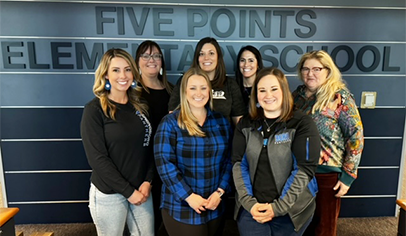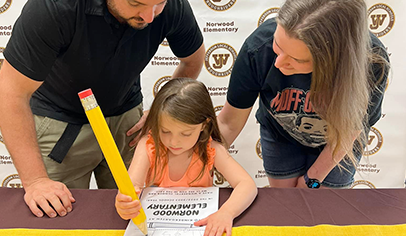The start of a new school year is a key time for any parent group. At the beginning of the year, parents pay the most attention to school details: registration, teachers, school supply lists, new rules for pickup and drop-off. This is a great time to get people interested in your group. It’s also a time when you’re most likely to see new faces at your meeting. If you want to turn those new faces into regular faces, or at least occasional volunteers, you have to be ready for them at that first meeting. The keys are to be welcoming and organized, to communicate well, and to follow up. Oh, and don’t do too much business.
Roll Out the Welcome Wagon
You want everyone to feel welcome and comfortable at every meeting. The higher the comfort level, the more likely people will put your next meeting date on their calendars. First, assign a member or two to serve as official greeters. Their job is to welcome everyone, introduce people to each other and, especially, to make sure that new people don’t feel isolated.
The informal period as people drift in is a valuable time for all of your board members to introduce themselves. You’ll have a chance to find out from parents what grades their children are in and where parents’ interests lie. Also, be sure to use name tags, for board members as well as attendees. The name tags put newcomers on an equal footing. Your regulars all know each other by name; this way newcomers can, too.
Starting your meeting with an informal exercise can set everyone at ease and be fun. Ask attendees to introduce themselves to two people they haven’t met and share their favorite movie or TV show. Or, if the group is not too large, have every attendee introduce herself.
A positive icebreaker question can also add some levity. That’s one of the tips offered on ptotoday.com by Gerise Weidner, immediate past president of the Clement Avenue School PTO in Milwaukee, Wis. “The first meeting of the year it was: What do you like best about our school?” she wrote.
At Heights Elementary in Sharon, Mass., one meeting began with each person sharing a favorite memory from elementary school. The stories were humorous, particularly the assistant principal’s tales of getting into trouble with the sisters who ran his Catholic school. Everyone in the group felt as if they knew one another a little better.
Another way to help people feel welcome is to offer refreshments. Let’s face it: Who doesn’t like a little chitchat over a cup of coffee and a piece of cake? Offering a bite to eat allows parents to socialize and gives board members a chance to meet people individually and possibly recruit new volunteers. A couple of pastry trays from your local wholesale club and a coffee percolator should do the trick. A little hospitality goes a long way.
An informal picnic on the school playground serves as the backdrop for the first PTO meeting of the year at Bach Elementary in Ann Arbor, Mich. Families bring their own dinners to the “welcome back” picnic, and the PTO provides dessert. Items on the agenda include introducing board members and talking about upcoming events, volunteer opportunities, and the scrip program, says PTO president Wendy Umbriac.
Be Organized and Efficient
If your first meeting lasts forever and gets little accomplished, you can bet attendance will be low at your next one. Show everyone that your PTO has its act together and respects people’s time.
Have a printed agenda for people to follow. Your first meeting’s business agenda might include:
-
An introduction of PTO officers and committee chairs. It feels less formal if you have people introduce themselves rather than having the president do it. Ask each officer to give a little personal information, including what grades her children are in. Also have officers give very brief descriptions of their duties.
-
An introduction of administrators and staff in attendance, such as the principal, assistant principal, guidance counselors, teachers, etc.
-
An explanation of what the PTO is, why it exists, its goals for the year, and what it supports. Give a brief overview of the budget, explaining how funds are raised and spent. Don’t be shy about stating your accomplishments and outlining your goals. Use this opportunity to get people excited about what you can all accomplish together.
-
An announcement of your next meeting date, time, and location.
Do (a Little) Business
It’s fine to do business at your first meeting, but keep it short. This is the wrong time to engage in a long debate on the merits of selling wrapping paper vs. cookie dough or the best way to handle teacher grants. Your meeting should last no more than an hour, including icebreakers, introductions, and any other special activities you choose to do.
According to Weidner, the Clement PTO board meets 30 minutes before each general meeting to take care of business details, meeting minutes, treasurer’s reports, and agendas. Anyone is welcome to attend this part of the meeting, and it allows the group to keep the general meeting to one hour or less. “It gives everyone a more friendly feeling,” she writes, “building relationships and showing an appreciation for their time. And we keep very open that nothing is being done in secret.”
When you do get down to business, make sure everybody knows what’s going on. Avoid insider talk that newcomers won’t understand. You don’t want to come across as a clique, making people attending for the first time feel like outsiders. It’s also important to encourage new people to speak up and to be welcoming of new ideas.
If You Have a Speaker, Make It Good
You want your organization to be relevant. If you decide to have a speaker, find a topic that is of concern to a majority of parents; for example, cyberbullying, Internet safety, drop-off/pickup changes, or bus fee/route changes. What you don’t want is a topic that is too hot-button; your meeting could turn into a public debate. While issues such as potential redistricting or changing the school start time can be a big draw, they also can be controversial. On the other hand, no one is against Internet safety. A local expert, technology teacher, or guidance counselor could give a talk and answer questions. (PTO Today offers access to a free, expert-led Internet safety presentation; all you have to do is pick a date.)
Veronica Wiseman, chairwoman of the Heights Elementary PTO in Sharon, Mass., has had success by combining speakers with business meetings. “By providing parents with the information they need, we give people something to come out for. Whether it’s the nurse, physical education instructors, or the technology teacher, we focus on the hot topics people want more information about.”
If your school has a new principal, assistant principal, or other administrator, this is a perfect opportunity to host a meet and greet in lieu of a formal speaker. If your school has a new program, such as peer counseling or diversity education, your meeting could be a good time to introduce the teacher to explain the curriculum. And don’t forget your school lunch program—parents are always concerned about what is available for their children to purchase. Your school district’s director of food service could discuss nutritional concerns and government guidelines.
Make the Next Step Easy
It’s also important to share information about how to volunteer. Be sure to mention that even an hour a semester will help, and that you have jobs that don’t have to be done at school or during the school day. And let people know that you value their talent as well as their time. Maybe there’s an avid gardener in your group who would like to help with school beautification or a writer who could do wonders for your newsletter. Encourage people to share their interests.
Have detailed volunteer forms available, listing specific committees, tasks, the times of year help is needed, and the time commitment required for each task. Having a detailed form can make a huge difference. Parents will be more likely to get involved if they know the time commitment in advance.
By listing specific tasks like grantwriting or public relations, for example, you’re more likely to get parents who do these jobs professionally to volunteer. They know what is required and how to get the job done. It’s a win-win situation: Your volunteer is using his talents to make a difference, and the PTO is getting top-notch quality from a professional it could not afford to hire.
And don’t forget to follow up. Call or email every person who fills out a volunteer form, even if the events for which they have volunteered are not until later in the school year. Too often parents offer their help and never hear back.
Have all your other forms ready to go at that first meeting, too: membership forms and email and newsletter signup. And if you publish an annual family directory, have that form on hand, as well.
Originally posted in 2010 and updated regularly.
























